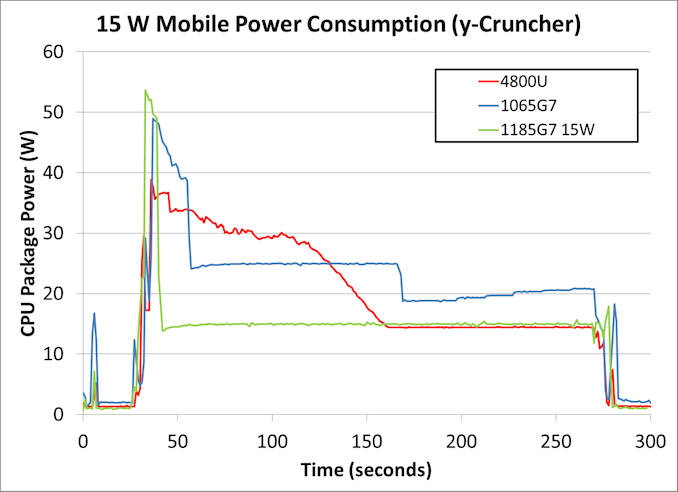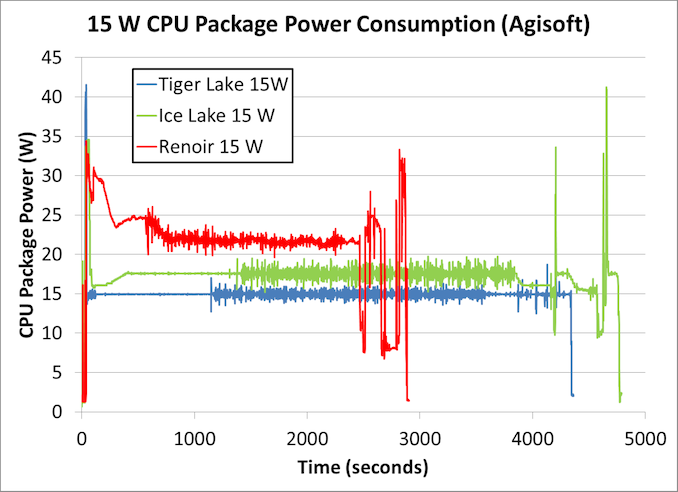Intel’s Tiger Lake 11th Gen Core i7-1185G7 Review and Deep Dive: Baskin’ for the Exotic
by Dr. Ian Cutress & Andrei Frumusanu on September 17, 2020 9:35 AM EST- Posted in
- CPUs
- Intel
- 10nm
- Tiger Lake
- Xe-LP
- Willow Cove
- SuperFin
- 11th Gen
- i7-1185G7
- Tiger King
Comparing 15 W TGL to 15 W ICL to 15 W Renoir
Despite the hullaballoo with the 28 W numbers on Tiger Lake, we suspect that most OEMs will still be positioning the hardware inside chassis built for the 15 W ultraportable market. This is where most of Intel’s OEMs have had success over the last decade, as the lower cooling requirements allow for a more user-friendly design. At 28 W, there is more of a cross-over into laptops that have discrete graphics options, and the main company that has succeeded in offering 28 W laptops without discrete graphics has been Apple - most Intel partners, if they want discrete graphics, end up looking at the 45 W processors with more cores.
So in that respect, our main battle should occur between the products built for 15 W. To that end we have been able to put the three together that will command this holiday season’s offerings: Ice Lake, Tiger Lake, and AMD’s Renoir.
- For our Ice Lake system, we have the Microsoft Surface Laptop 3. This has the top-of-the-line quad-core Core i7-1065G7, along with 16 GB of LPDDR4X-3733. Base 1.3 GHz, Turbo 3.9 GHz. Because this is an OEM design, Microsoft have determined the PL1 and PL2 values, and so they might be different from a ‘base’ design, however this is data from a real system.
- The Tiger Lake system is our Reference Design from Intel, running the quad-core Core i7-1185G7 at 15 W TDP mode. It has 16 GB of LPDDR4X-4266. Base 1.8 GHz, Turbo 4.8 GHz.
- Our AMD Renoir system is one of the most premium examples of AMD’s Ryzen Mobile in a 15W form factor, the Lenovo Yoga Slim 7 with the eight-core Ryzen 7 4800U processor. Even when set to the highest performance mode, the system still operates with a 15 W sustained power draw. It comes equipped with 16 GB of LPDDR4X-4266. Base 1.8 GHz, Turbo 4.2 GHz.
Compute Workload
For our 15 W comparisons, we can look again at the same benchmarks as the previous page. First up is y-Cruncher, an AVX2/AVX512 compute workload that tasks the CPU and the memory by calculating 2.5 billion digits of Pi, and requires ~11 GB of DRAM.
As we saw on the previous page, our Tiger Lake system in green at 15 W turbos up to ~53 watts before very quickly coming down to 15 W for the rest of the test.
The Microsoft Surface Laptop 3, by virtue of an OEM system, has different behavior - it turbos for longer, settles into a short turbo limit of 25 W, and then after about two minutes comes down to 20 W. The system then appears to opportunistically up the power draw until the end of the test, likely due to detecting extra thermal headroom.
The AMD Renoir processor does not turbo as high, peaking at only 38.9 W. Over the course of the next 100 seconds or slow, we see a small ramp down to just under 30 watts, before a more consistent decline over 30 seconds to 15 W, before staying at 15 W for the full test. The Renoir here has eight cores rather that four, but is running AVX2 rather than AVX-512 code.
The results are as follows:
- Ice Lake: 233 seconds, for 6072 joules, averaging 26.1 W
- Tiger Lake: 241 seconds for 4082 joules, averaging 17.0 W
- Renoir: 234 seconds for 5386 joules, averaging 23.0 W
All three systems perform the test in roughly the same amount of time, however the Tiger Lake system is very much ahead for efficiency. Tiger Lake effectively shaves off a third of the power from the previous generation Ice Lake system. We weren’t expecting this much of a jump from Ice Lake to Tiger Lake, but it would appear that Intel has done some work on the AVX-512 unit, and is putting that new high-performance transistor to use.
Professional ISV Workload
Moving onto the Agisoft test - as mentioned on the previous page, this is a 2D image to 3D modeling workflow where the algorithm comes in four stages, some of which prefer full multi-thread throughput, while others are more frequency and memory sensitive.
First, the Renoir finishes in almost half the time, mostly due to the fact that it has double the number of cores - there is no AVX-512 codepath in this test, and so all the processors rely on a mix of SSE, AVX, and perhaps some AVX2. That aside, the turbo behavior of Renoir is very interesting - we get almost 10 minutes of higher-than-base performance before the algorithm sets into a routine, hovering around 22 W. Because this test doesn’t attack the vector units as hard as the previous test, it may be a case that the Renoir system can manage the power distribution a bit better between the eight cores, allowing for the higher turbo.
Between the Ice Lake and the Tiger Lake, from the graph it would appear to be a double win for Tiger Lake, finishing in a shorter time but also consuming less power. The results are:
- 15 W Renoir: 2842 seconds for 62660 joules
- 15 W Ice Lake: 4733 seconds for 82344 joules
- 15 W Tiger Lake: 4311 seconds for 64854 joules
In this case, it’s a win for Renoir - a lot shorter time, and better power to boot, derived from the eight cores built on TSMC 7nm. Tiger Lake still represents a good jump over Ice Lake, offering 10% better performance at only 79% of the power, or a 13% increase in performance efficiency.












253 Comments
View All Comments
MDD1963 - Saturday, September 19, 2020 - link
Although equaling/exceeding 7700K-level of performance within a 50W envelope in a laptop is impressive, the 4c/8t design is going to cause at least one or two frowns/raised eyebrows...ballsystemlord - Saturday, September 19, 2020 - link
@Ian why do these companies always seem to have the worst timing on sending you stuff? Do you tell them when you'll be on vacation?Thanks for the review!
Ian Cutress - Sunday, September 20, 2020 - link
It's happened a lot these past couple of years. The more segments of the tech industry you cover, the less downtime you have - my wife obviously has to book holiday months in advance, but companies very rarely tell you when launches are, or they offer surprise review samples a few days before you are set to leave. We do our best to predict when the downtime is - last year we had hands on with the Ice Lake Development system before the announcement of the hardware, and so with TGL CPUs being announced first on Sep 2nd, we weren't sure when the first units were coming in. We mistimed it. Of course with only two/three of us on staff, each with our own segments, it's hard to get substitutes in. It can be done, Gavin helped a lot with TR3 for example. But it depends on the segment.And thanks :)
qwertymac93 - Sunday, September 20, 2020 - link
Finally a decent product from Intel. It's been a while. Those AVX512 numbers were impressive. Intel is also now able to compete toe to toe with AMD integrated graphics, trading blows. I feel that won't last, though. AMD is likely to at least double the GPU horsepower next gen with the move from a tweaked GCN5 to RDNA2 and I don't know if Intel will be able to keep up. Next year will be exciting in any case.Spunjji - Sunday, September 20, 2020 - link
It'll be a while before we get RDNA2 at the high end - looks like late 2021 or early 2022. Before that, it's only slated to arrive with Van Gogh at 7-15Wefferz - Monday, September 21, 2020 - link
It is very interesting to see that the intel complier make the SPECint2017 scores 52% higher than other compliers without 462.libquantum.helpMeImDying - Thursday, September 24, 2020 - link
Hello, before ranting I want to know if the scores of spec2006 and spec2017 were adjusted/changed based on processors frequency(Read something like that in the article)? Because you can't do that. Frequencies should be out of the topic here unless comparing same generation CPU's and even then there are some nuances. What matters is the performance per watt comparing low power notebooks. It can be done mathematically, if the TDP can't be capped at the same level all the time, like you did in the first few pages. I'm interested in scores at 15W and 25W. So you should have and should in the future monitor and publish power consumed numbers near the scores.And if you are adjusting scores based on CPU frequencies, then they are void and incorrect.
helpMeImDying - Thursday, September 24, 2020 - link
Btw, same with iGPUs.beggerking@yahoo.com - Friday, September 25, 2020 - link
none of the tests seem valid... some are intel based others are AMD based... I don't see a single test where Ryzen beats 10th gen but loses to 11th gen on standard 15 watt profile...the speed difference between 10th and 11th gen intel is approx 10-15%.. its good, but probably not worth the price premium since Ryzen is already cheaper than 10th gen, i don't see how 11th gen would go cheaper than Ryzen...
legokangpalla - Monday, September 28, 2020 - link
I always thought AVX-512 was a direct standoff against heterogenous computing.I mean isn't it a better idea to develop better integrations for GPGPU like SYCL, higher versions of OpenCL etc? Programming with vector instructions IMO is lot more painful compared to writing GPU kernels and tasks like SIMD should be offloaded to GPU instead being handled by CPU instruction(CPU instruction with poor portability).